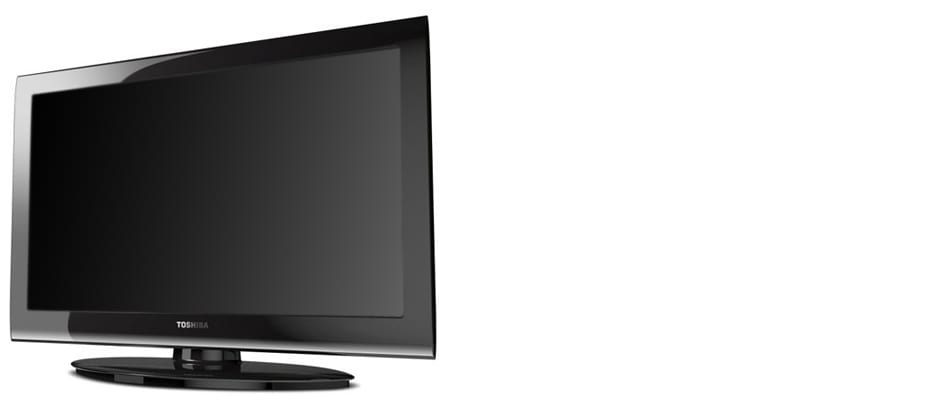Introduction
Overall Design
{{section_header}}{{section.name}}{{/section_header}}
The {{product.name}} looks like any other boxy, black TV in most regards, except for a silvery blue streak that runs along the bottom of the bezel. Above that is a dot screen pattern that transitions from black to grey. Stepping outside of traditional design is always risky, so we'll give Toshiba some credit for trying. But most of our editors found this to be a misstep – cheap looking, mostly.
Front
{{section_header}}{{section.name}}{{/section_header}}

Back
{{section_header}}{{section.name}}{{/section_header}}

Sides
{{section_header}}{{section.name}}{{/section_header}}

Stand/Mount
{{section_header}}{{section.name}}{{/section_header}}
The stand that attaches to the panel of the {{product.name}} is large and ovular, with sharp corners on either end. It is definitely not an attractive shape. The only thing good we can say about it is that at least it's not too big. We've seen what same base looks like on a 50-inch Toshiba, and it's not pretty.

Controls
{{section_header}}{{section.name}}{{/section_header}}
The controls are located on the left-hand side of the TV. They're hard buttons, rather than the "touch-sensitive area" buttons we see on a lot of TVs. We prefer these, as they're easy to find in the dark and don't leave fingerprints.

Remote Control
{{section_header}}{{section.name}}{{/section_header}}
The {{product.name}}'s remote control is not great. The buttons are cramped and laid out in a less than intuitive manner. The key travel – the distance you have to push down the button to get a response – is much too far. When you put a good remote control in your hand, your fingers learn it quickly and can find buttons without your eyes. Not so, here, where it just doesn't have that pleasant tactility of an LG or Samsung remote.

In the Box
{{section_header}}{{section.name}}{{/section_header}}
The {{product.name}} comes with the remote control & batteries, stand & screws, and some assorted documentation. That is all.
Black Level
{{section_header}}{{section.name}}{{/section_header}}
The {{product.name}} produced a great black level for an LCD, measuring 0.08 cs/m2. We've tested plasma TVs (typically celebrated for their black level), that aren't that good. More on how we test black level.
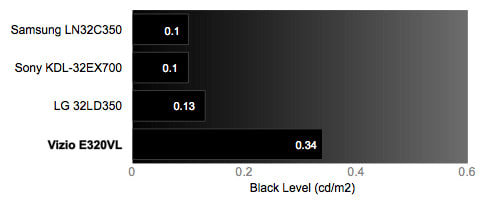
Peak Brightness
{{section_header}}{{section.name}}{{/section_header}}
The {{product.name}} is an astonishingly bright television. As you can see in the chart below, its whites are significantly brighter than the competition. In fact, it's among the brightest TVs we've tested. That's not a particularly important asset for a TV to have, but it could come in use if you watch movies in a sunny room every day, wherein a TV has to compete with strong ambient light. More on how we test peak brightness.
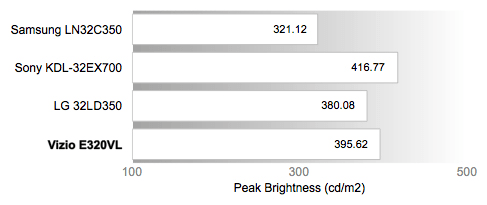
Contrast
{{section_header}}{{section.name}}{{/section_header}}
Thanks to a great black level and blazing peak white, the contrast ratio measured a healthy 5840:1. As you can see in the chart, the Sony BX420's black levels gave it an advantage here. More on how we test contrast.

Tunnel Contrast
{{section_header}}{{section.name}}{{/section_header}}
The {{product.name}} has little trouble maintaining a consistent black level, no matter how much or how little black is on the screen. More on how we test tunnel contrast.
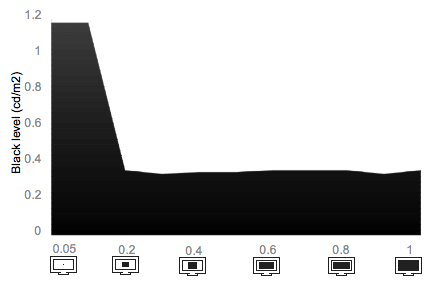
White Falloff
{{section_header}}{{section.name}}{{/section_header}}
The {{product.name}} produces a perfectly level peak brightness, regardless of screen content at the time. More on how we test white falloff.
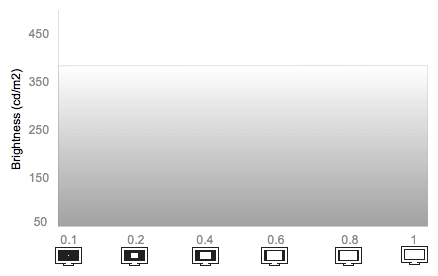
Uniformity
Greyscale Gamma
{{section_header}}{{section.name}}{{/section_header}}
The greyscale gamma test measures how well a TV transitions from black to white within the greyscale. Overall, the {{product.name}} gave a strong performance – far better than the Toshiba C110 series. We're not sure what the relationship is between the C110 and the E210 series, but they share the same instruction manual.
The {{product.name}} showed a smooth response curve, for the most part. There are a couple of hiccups in the line, which indicate areas where you might see some banding rather than a smooth gradient. The slope of the line is a little steep. An ideal slope is between 2.1 and 2.2, while the {{product.name}} has a slope of 2.85. This means the TV will miss some of the finer gradations. Overall, though, it's a good performance. More on how we test greyscale gamma.
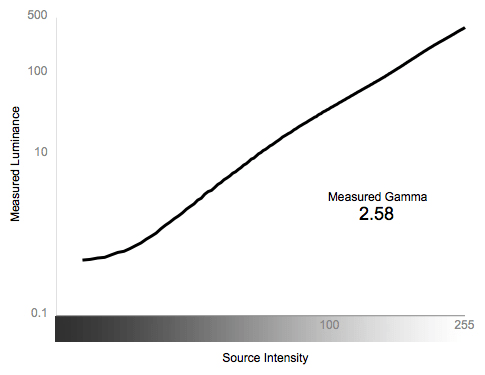
Color Temperature
{{section_header}}{{section.name}}{{/section_header}}
The color temperature of the {{product.name}} tends to warm as the signal gets darker. It's a gradual change, so you might not notice it. More on how we test color temperature.

RGB Curves
{{section_header}}{{section.name}}{{/section_header}}
The {{product.name}} produced good, smooth color curves, as you can see in the chart below. That indicates that you'll get smooth color gradients on objects like fabrics, green leaves, blue skies, and anything else where you have dark-to-light transitions within a single color. If you look at the chart below, you can see that the red channel is brighter than the blue and green channel, but it also peaks early. There's very little differentiation in the brightest red levels. More on how we test RGB curves.

The color strips below are digital recreations of the RGB color curve test data, compared to three similar TVs, as well as an ideal response curve.
Motion Performance
{{section_header}}{{section.name}}{{/section_header}}
Like most LCD TVs we review, the {{product.name}} showed some signs of judder – a kind of wobbliness – when objects move horizontally across the screen. There was also a sort of "scanning" effect where jagged lines traversed through objects, an effect we're attributing to laggy processing and slow pixel response times. We were quite pleased to see, however, that there was very little artifacting, such as color trails, halos, or color smearing. All in all, it was a strong performance, especially for a budget TV. More on how we test motion performance.
3:2 Pulldown & 24fps
{{section_header}}{{section.name}}{{/section_header}}
The {{product.name}} had no problems with native 24fps content, like you get with a lot of Blu-Ray movies. In order to get the best performance, locate the Cinema Mode feature in the menu and set it to the Film setting. That will help eliminate some of the judders in horizontal movements. More on how we test 3:2 pulldown and 24fps.
Resolution Scaling
{{section_header}}{{section.name}}{{/section_header}}
The {{product.name}} has a native resolution of 1080p (1920 x 1080). However, much of the content you'll feed the TV will be of a lower resolution. It's up to the TV's internal processing to take that picture and scale it up to fit the screen. Fortunately, the E210 is quite adept at the task. More on how we test resolution scaling.
480p
The 480p content we tested on the {{product.name}} had absolutely no problems. Be sure to change the Picture Size to Native, otherwise some of the edges may be cut off.
720p
The 720p test screens showed the slightest trouble with high contrast / high frequency patterns – a certain striped Moire effect at a few frequencies. We doubt this will have an impact on your everyday viewing.
Formats
{{section_header}}{{section.name}}{{/section_header}}
The {{product.name}} has a 1080p (1920 x 1080) native resolution, and can adequately handle all standard NTSC broadcast resolutions.
Viewing Angle
{{section_header}}{{section.name}}{{/section_header}}
The {{product.name}}, like many LCDs, has a narrow viewing angle. We clocked it at about 49 degrees, or 24 degrees from center in either direction. As you can see in the chart below, other LCD TVs performed similarly. A plasma TV would easily double or triple this score.

Reflectance
{{section_header}}{{section.name}}{{/section_header}}
The {{product.name}} was unfortunate to have a fairly reflective screen. That means that ambient light will definitely cut down on contrast ratio.
Video Processing
{{section_header}}{{section.name}}{{/section_header}}
The {{product.name}} has just two video processing features, neither of which add much to the picture quality.
Calibration
{{section_header}}{{section.name}}{{/section_header}}
To calibrate the {{product.name}}, just put it in Movie mode and follow our instructions in the table below.

All of our calibration is done in conjunction with the DisplayMate software.
](http://www.displaymate.com/)
Video Modes
{{section_header}}{{section.name}}{{/section_header}}
The {{product.name}} has four video preset modes. We recommend Movie mode for the best color performance. If you make changes to any of the settings in these modes, it will automatically save your changes in a fifth mode called Preference.
Connectivity
{{section_header}}{{section.name}}{{/section_header}}
The {{product.name}} is equipped with only the most basic connectivity options, making it less than an ideal choice for your home theater hub. There are just two HDMI ports, while most HDTVs offer three or four. There's also only one component AV and one composite AV input. There's a digital audio output, but no analog audio output to connect to older home audio systems. (Trust us, you'll want a separate audio system after hearing the built-in speakers).

On the side, you'll find a single USB port for connecting to USB mass storage devices like thumb drives.
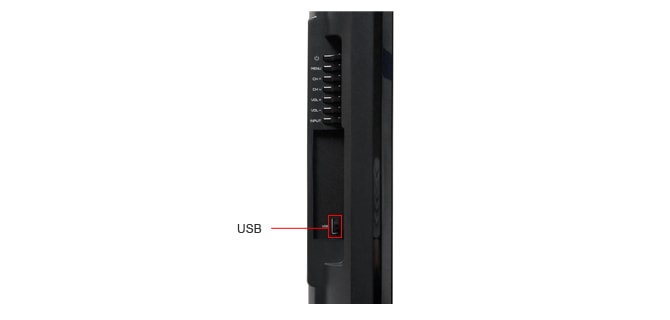
Placement
{{section_header}}{{section.name}}{{/section_header}}
Most of the ports are located on the back, and we really could have done for an AV port on the side. The TV panel does not swivel on its base, and at 40 inches, it's not the lightest thing to pick up and spin around.
Audio Quality
{{section_header}}{{section.name}}{{/section_header}}
The audio quality of the built-in speakers on the {{product.name}} is just plain awful. These two 7W speakers sound like little more than headphones turned up at high volume and heard from a distance (well, maybe a little better than that, but not by much). There is absolutely no bass response and there's little you can do to improve the performance. The menu has bass and treble controls only, no equalizer, no sound modes, and no surround sound emulator. You usually get at least one of those amenities in a budget TV.
Menu Interface
{{section_header}}{{section.name}}{{/section_header}}
The menu system on these budget Toshiba TVs is not pretty, but it is simple and straightforward. That has a lot of appeal after you've experienced a beautiful but overly-complex menu (we're looking at you, Sony). It's very hard to get lost in the Toshiba menus. Everything else laid out right there. The only thing slowing you down is the remote control, with its crowded and confusing button layout.

You also need to point the remote directly at the IR sensor on the bottom-left of the TV. We found ourselves hitting the buttons several times to get a response.

Instruction Manual
{{section_header}}{{section.name}}{{/section_header}}
The instruction manual that ships with the {{product.name}} covers four distinct models, each with a number of small but noticeable differences. As a result, there's the equivalent of a lot of hemming and hawing about which feature is found on which particular model. It's not nearly as bad as an LG instruction manual, which may cover up to 40 different TVs, but we're not sure why it would be so hard to make a unique manual for each model.

A manual for so many TV models, they have to be further categorized by type.
Local Media Playback
{{section_header}}{{section.name}}{{/section_header}}
The {{product.name}} has a USB port on the side that can connect to USB mass storage devices, like thumb drives. From here, you can play photos (JPEGs only) and audio files (MP3s only). As with the other menus, the interface is far from pretty, but it's intuitive enough.
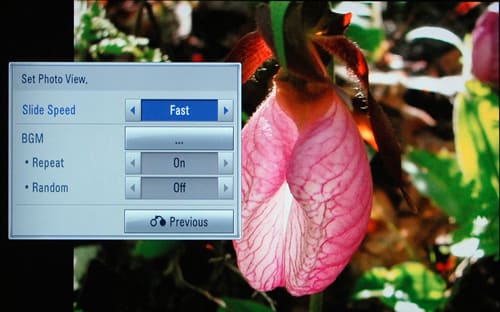
Once you have the device plugged in, you can create custom slideshows or song playlists.
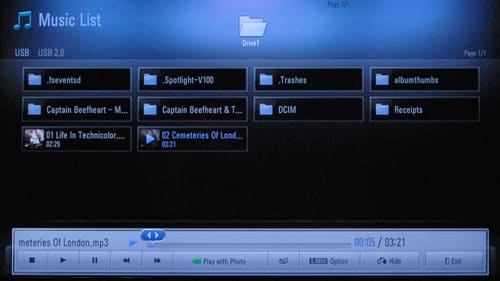
Power Consumption
{{section_header}}{{section.name}}{{/section_header}}
The only notable find in our power testing was discovering once again just how bright this TV was. With the backlight turned all the way up, the peak brightness hit a whopping 400+ cd/m2. That will cost you about $31.50 per year in electricity costs. But our final scoring is based on lowering the backlight until the whites are peaking at around 200 cd/m2. That brought the electricity cost down to $15.30 per year.
As you can see, the {{product.name}} stands up well to the competition. Note, however, that screen size is one of the determining factors in power consumption. The Sony has a 46-inch screen and the Insignia has a 42-inch screen. The LG, however, has a smaller, 37-inch screen and actually uses more power.
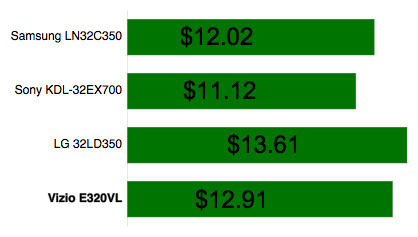
Value Comparison
{{section_header}}{{section.name}}{{/section_header}}
We reviewed the 46-inch Sony KDL-46BX420 ($899 MSRP), but there's a 40-inch version available for $699, or $100 more than the {{product.name}}. The Sony's performance is generally outstanding, with great color, a fantastic contrast ratio, and a 1080p resolution that can handle all your broadcast needs adeptly. The only drawbacks were a lack of connectivity options and some lack of detail when displaying shadows.
Blacks & Whites
{{section_header}}{{section.name}}{{/section_header}}
The Sony BX420 produced a fantastic black level of 0.04 cd/m2. That was quite a bit darker than {{product.name}}. As a result, the Sony's contrast ratio is much wider.

Color Accuracy
{{section_header}}{{section.name}}{{/section_header}}
The Sony's color performance was better in every test – smoother color transitions, a more consistent color temperature, and a more accurate color gamut.
Motion
{{section_header}}{{section.name}}{{/section_header}}
We noticed more motion artifacting in the Sony BX420, but more judder in the {{product.name}}. Each has its failings, but both are good enough for the price point.
Viewing Effects
{{section_header}}{{section.name}}{{/section_header}}
Both the {{product.name}} and the Sony BX420 are LCD televisions with their typically narrow viewing angle.
Connectivity
{{section_header}}{{section.name}}{{/section_header}}
Neither TV has great connectivity options. They're virtually identical, though the Sony has an analog audio output.
Value Comparison
{{section_header}}{{section.name}}{{/section_header}}
The LG LK450 series ($599 for the 37-inch and $699 for the 42-inch) are a little more expensive than the {{product.name}}, but it's money well spent. The contrast ratio pales in comparison to the Toshiba, but the color performance is near perfect and the motion performance is smoother. It offers more connectivity options and a better interface. The only real drawback is the faux wood panel along the bottom, reminiscent of an Atari 2600. Overall, we would definitely choose the LG.
Blacks & Whites
{{section_header}}{{section.name}}{{/section_header}}
The major performance weakness of all the LG LCDs we've reviewed in 2011 is the black level, which is far brighter than the {{product.name}}. As a result, the contrast ratio is just a fraction of the Toshiba's.

Color Accuracy
{{section_header}}{{section.name}}{{/section_header}}
LG can't be beat for color performance in its LCD TVs (their plasma TVs are another matter).
Motion
{{section_header}}{{section.name}}{{/section_header}}
We also thought the motion performance was smoother on the LG LK450 series than on the {{product.name}}.
Viewing Effects
{{section_header}}{{section.name}}{{/section_header}}
The viewing angles on the LG LK450 and the {{product.name}} are virtually identical. Both are quite narrow.
Connectivity
{{section_header}}{{section.name}}{{/section_header}}
The LK450 offers one additional HDMI, composite AV input, and component AV input. It also has an analog audio output for connecting to headphones and older home audio systems.
Value Comparison
{{section_header}}{{section.name}}{{/section_header}}
Insignia, one of Best Buy's house brands, tends to skimp on frills and (hopefully) focus on performance and value. The NS-42L780A12 certainly followed that path. It looks and feels cheap, with ugly menus and impossible-to-access ports. However, the performance was quite good. The {{product.name}} is hardly a catwalk model, so it's hard to advocate for either when it comes to the TV serving as an objet d'art in your living room. That said, the Insignia is probably the better value.
Blacks & Whites
{{section_header}}{{section.name}}{{/section_header}}
The Toshiba has a much wider contrast ratio, thanks to deep black levels that the Insignia couldn't match.

Color Accuracy
{{section_header}}{{section.name}}{{/section_header}}
The Insignia showed very strong color performance, beating the {{product.name}} in every test we run.
Motion
{{section_header}}{{section.name}}{{/section_header}}
The motion performance proved better on the Insignia, which was smoother and showed fewer, if any, artifacting.
Viewing Effects
{{section_header}}{{section.name}}{{/section_header}}
Both TVs are LCDs, and most exhibited the typically narrow viewing angle. If you need a wider viewing angle, you should consider a plasma TV.
Connectivity
{{section_header}}{{section.name}}{{/section_header}}
The Insignia has one additional HDMI, as well as an analog audio output, but accessing the ports on the back is very difficult, as they're angled upward and hidden under a shelf. However, it has some AV ports on the side that you can use for quick swaps.
Conclusion
Entry-level and budget TVs like the {{product.name}} ($599 MSRP) are always a study in tradeoffs. You can tell immediately that it didn't receive the care and attention to design you see in most Samsungs and Sonys. The physical components are crude. The remote control is cluttered and requires a lot of finagling to get a response. The menus are downright ugly.
That said, the menus are straightforward. The TV's overall design is simple. Everything works just fine (except the remote control). We liked the performance, for the most part. The color curves were smooth and the contrast ratio was impressive. The motion performance was marred by a little judder but few other problems.
You can find better budget TVs at this size (try the Sony BX420) or even cheaper TVs that are just as good at video performance (Insignia NS-42L780A12). You probably won't hate the {{product.name}}, but you won't love it either.
Photo Gallery
{{photo_gallery "Front Tour Image", "Back Tour Image", "Sides Tour Image", "Stand Photo", "Controls Photo", "Remote Control Photo", "Connectivity Tour Image 1", "Connectivity Tour Image 2", "Connectivity Extra Photo", "Menu Main Photo", "Menu 2 Photo", "Internet Features 1 Photo", "Internet Features 2 Photo", "Internet Features 3 Photo", "Local Media Playback 1 Photo", "Local Media Playback 2 Photo"}}
Ratings & Specs
{{manufacturer_specs_table}}
Meet the tester
David Kender oversees content at Reviewed as the Editor in Chief. He served as managing editor and editor in chief of Reviewed's ancestor, CamcorderInfo.com, helping to grow the company from a tiny staff to one of the most influential online review resources. In his time at Reviewed, David has helped to launch over 100 product categories and written too many articles to count.
Checking our work.
Our team is here for one purpose: to help you buy the best stuff and love what you own. Our writers, editors, and lab technicians obsess over the products we cover to make sure you're confident and satisfied. Have a different opinion about something we recommend? Email us and we'll compare notes.
Shoot us an email
